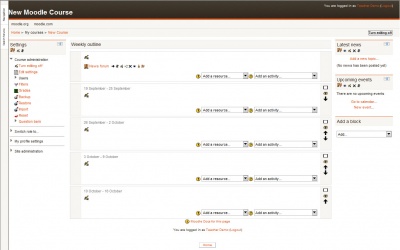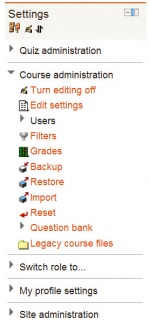Creating a course: Difference between revisions
Berrill Ley (talk | contribs) mNo edit summary |
|||
| Line 56: | Line 56: | ||
[[Image:Activity_dropdown.JPG|frame|right|Add an activity drop-down menu]] | [[Image:Activity_dropdown.JPG|frame|right|Add an activity drop-down menu]] | ||
There are a number of interactive learning [[ | There are a number of interactive learning [[Activity | activity modules]] that you may [[Adding_resources_and_activities | add to your course]]. | ||
Communication and collaboration may take place using [[Chats]] and [[Forums]] for conversational activities and [[Choices]] to gain group feedback. Adding [[Wikis]] to your courses is an excellent way to allow students to work together on a single piece. | Communication and collaboration may take place using [[Chats]] and [[Forums]] for conversational activities and [[Choices]] to gain group feedback. Adding [[Wikis]] to your courses is an excellent way to allow students to work together on a single piece. | ||
Revision as of 03:58, 8 September 2011
This page really needs improving. Please see the page comments for suggestions of what to include, then remove this template when you're done.
Essentially the heart of a Moodle course is usually divided into sections (Topics or Weeks). The course creation process consists of
- Planning the layout, activities and resources which will best meet the course goals
- Naming sections
- Adding Resources and Activities to the sections
- Editing or adding Blocks.
- Testing the course as a student
Getting started
First, you will need to Log in to Moodle, be enrolled in a course in a Teacher's role and then you can start to use most of the features below. We have some tips if you are having trouble logging in. Now on to some details, we will have lots of embedded links in the text.
The initialcourse homepage is broken down into Course sections. Teachers build their course by adding resources, activities and Blocks to .
The example above, a teacher is looking at a new course in edit mode. It has 5 topic sections in the center and there are blocks on both sides of the center column. The sections are empty. The teacher can add resources and activities to the sections, blocks on either side can be deleted, moved or new ones added. Each Moodle site's new course may look different but the elements of activities, resources and block will be there.
Editing a course
To add or alter activities or resources a teacher will need to "turn editing on" and off with a button on the course homepage. There is also a "Turn editing on" link in the Settings > Course administration block. These buttons and links toggle between on and off.
Note: writing text in Moodle you have a range of Formatting options including using HTML in Moodle.
Common editing icons
When editing is on you will see the following icons:
 - the edit icon lets you alter/update whatever resource or activity it is next to by taking you to its setup page.
- the edit icon lets you alter/update whatever resource or activity it is next to by taking you to its setup page.
 - the open-eye icon means an item is visible to students. Clicking it will make the item invisible to participants and change the icon to the closed eye.
- the open-eye icon means an item is visible to students. Clicking it will make the item invisible to participants and change the icon to the closed eye.
 - the closed-eye icon means an item is hidden from students. Clicking it will make the item visible to participants and change the icon to the open eye.
- the closed-eye icon means an item is hidden from students. Clicking it will make the item visible to participants and change the icon to the open eye.
 - the move here icon appears when moving a course element. It appears only after you've clicked the move icon, and indicates the destination of the item you're moving.
- the move here icon appears when moving a course element. It appears only after you've clicked the move icon, and indicates the destination of the item you're moving.
 - the delete icon will permanently delete something from the course after you confirm a warning on a second page.
- the delete icon will permanently delete something from the course after you confirm a warning on a second page.
Activity modules
There are a number of interactive learning activity modules that you may add to your course.
Communication and collaboration may take place using Chats and Forums for conversational activities and Choices to gain group feedback. Adding Wikis to your courses is an excellent way to allow students to work together on a single piece.
Work can be submitted by students and marked by teachers using Assignments or Workshops. Automatic marking can be achieved by using Quizzes. You can even integrate your Hot Potato quizzes by adding a Hotpot activity.
Content may be delivered and supported using Lesson module and SCORM activities. Key words can be added to Glossaries by yourself or, if you allow it, your students.
Surveys and Databases are also very powerful additions to any course.
If all of that isn't enough for you then you can also add contributed modules that are not part of the official Moodle release!
Resources
Moodle supports a range of different resource types that allow you to include almost any kind of digital content into your courses. These are added with the "Add a resource" dropdown box when editing is turned on.
Adding a File, Folder, IMS content package or URL resource may lead to the File picker when you add content. This will allow you to use existing files located in Repositories or upload a new resource.
Blocks
Each course homepage generally contains blocks on the left and right with the centre column containing the course content. Blocks may be added, hidden, deleted, and moved up, down and left/right when editing is turned on. Examples of blocks can be see in the Getting Starting image above. "Latest News", "Upcoming Events", and "Recent Activity" are blocks.
A wide range of blocks exist that can provide additional information or functionality to the learner or teacher. There are both standard blocks that come with Moodle and many contributed blocks developed by Moodlers that an administrator can add to a Moodle site.
The teacher will have a Settings block and a Navigation block that sometimes share common pages via their submenu links. Both these block's menu system will change depending upon Context (what is being done at the moment). Most of our instructions will use the Settings block's menu system.
Course administration
The Course administration menu allows teachers to Edit course settings, manage users( for example student and teacher enrollments and groups), view the course Grades menu, and access the Teacher_forum. Some teachers will find the backup, Restore, Import (course data) and Reset course links are handy tools when creating similar courses. Naturally a teacher will want to look at Grades and the question bank database, used in quizzes/tests or in the Lesson module.
The links in the Course administration block are only available to teachers of the course. Students will receive their own version of the Settings block which will display a link to their own gradebook and, if enabled, their own course logs. As a teacher, you can change the way students (and other teachers) access and view your course by exploring the Edit settings option in the Course administration menu.
General advice
- Subscribe yourself to all of the forums in your course so that you can keep in touch with your class activity.
- Encourage all of the students to fill out their user profile (including photos) and read them all - this will help provide some context to their later writings and help you to respond in ways that are tailored to their own needs.
- Keep notes to yourself in the private "Teacher's Forum". This is especially useful when team teaching.
- Use the Logs link to get access different student activity reports such as Live logs and course Statistics. For example, Live logs is a popup window that updates every sixty seconds and shows the last hour of activity in your course. This is useful to keep open on your desktop all day so you can feel in touch with what's going on in the course.
- Use the Activity Reports (next to each name in the list of all people, or from any user profile page). These provide a great way to see what any particular person has been up to in the course.
- Respond quickly to students. Don't leave it for later - do it right away. Not only is it easy to become overwhelmed with the volume that can be generated, but it's a crucial part of building and maintaining a community feel in your course.
- Don't be afraid to experiment: feel free to poke around and change things. It's hard to break anything in a Moodle course, and even if you do it's usually easy to fix it.
- Use the navigation bar at the top of each page - this should help remind you where you are and prevent getting lost
See also
- Teaching with Moodle - inspiring links
- Teaching do's and don'ts - hints
- Moodle manuals - A list of links to manuals and books
- Using Moodle book - A real book you can reprint!
- Teaching FAQ - common questions
- Course teaching checklist
- Teaching tips and tricks
- Student FAQ - students have questions about technology?
- Video tutorial on editing a course home page using AJAX. AJAX (Asynchronous Javascript and XML) can move blocks around the page by dragging.

